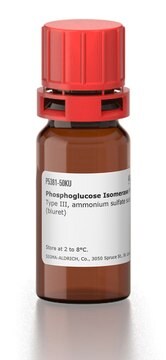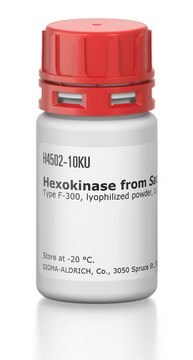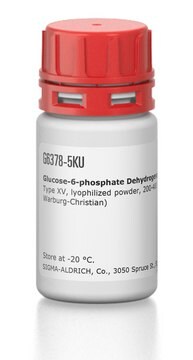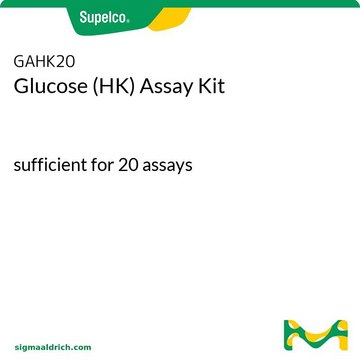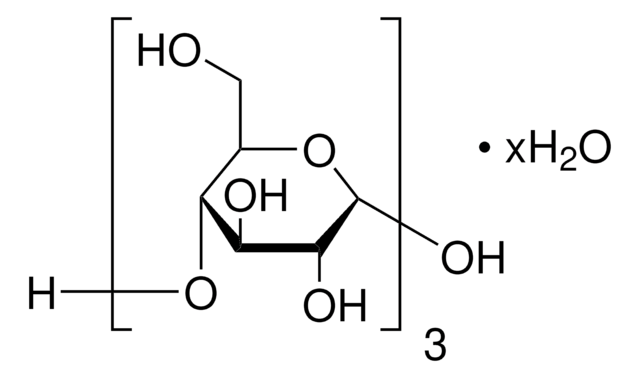P9544
Phosphoglucose Isomerase from rabbit muscle
Type XI, lyophilized powder, ≥200 units/mg protein
Sinônimo(s):
D-Glucose-6-phosphate ketol-isomerase, PGI, Phosphosaccharomutase
Faça loginpara ver os preços organizacionais e de contrato
About This Item
Produtos recomendados
fonte biológica
rabbit muscle
tipo
Type XI
Formulário
lyophilized powder
atividade específica
≥200 units/mg protein
composição
protein, 70-100% biuret
temperatura de armazenamento
−20°C
Procurando produtos similares? Visita Guia de comparação de produtos
Aplicação
Phosphoglucose Isomerase (PGI) is an enzyme crucial for the interconversion of D-glucose 6-phosphate and D-fructose 6-phosphate. PGI is responsible for the second step of glycolysis and is involved in glucogenesis. It is highly conserved in bacteria and eukaryotes. It is used in sugar assays to convert fructose to glucose . Product 9544 is type XI and is from rabbit muscle. It is useful in enzyme systems requiring low sulfate.
Ações bioquímicas/fisiológicas
Phosphoglucose Isomerase fuctions as an isomerase, neuroleukin, autocrine motility factor, and a differentiation and maturation mediator . It is responsible for the photosynthetic reduction of carbon.
Definição da unidade
One unit will convert 1.0 μmole of D-fructose 6-phosphate to D-glucose 6-phosphate per min at pH 7.4 at 25 °C.
forma física
Essentially sulfate-free powder containing citrate buffer salts
Palavra indicadora
Danger
Frases de perigo
Declarações de precaução
Classificações de perigo
Resp. Sens. 1
Código de classe de armazenamento
10 - Combustible liquids
Classe de risco de água (WGK)
WGK 1
Ponto de fulgor (°F)
Not applicable
Ponto de fulgor (°C)
Not applicable
Equipamento de proteção individual
Eyeshields, Gloves
Escolha uma das versões mais recentes:
Já possui este produto?
Encontre a documentação dos produtos que você adquiriu recentemente na biblioteca de documentos.
Os clientes também visualizaram
B K Campbell et al.
Reproduction (Cambridge, England), 140(5), 721-732 (2010-08-19)
Glucose is a critical metabolic fuel in most mammals although many foodstuffs also contain high levels of the monosaccharides, galactose and fructose. The aims of this work were to determine the insulin response to challenges of these sugars (experiment 1)
C J Jeffery et al.
Biochemistry, 39(5), 955-964 (2000-02-02)
The multifunctional protein phosphoglucose isomerase, also known as neuroleukin, autocrine motility factor, and differentiation and maturation mediator, has different roles inside and outside the cell. In the cytoplasm, it catalyzes the second step in glycolysis. Outside the cell, it serves
Veera Kainulainen et al.
Journal of bacteriology, 194(10), 2509-2519 (2012-03-06)
Glutamine synthetase (GS) and glucose-6-phosphate isomerase (GPI) were identified as novel adhesive moonlighting proteins of Lactobacillus crispatus ST1. Both proteins were bound onto the bacterial surface at acidic pHs, whereas a suspension of the cells to pH 8 caused their
Simone Frédérique Brenière et al.
PLoS neglected tropical diseases, 6(5), e1650-e1650 (2012-06-12)
The current persistence of Triatoma infestans (one of the main vectors of Chagas disease) in some domestic areas could be related to re-colonization by wild populations which are increasingly reported. However, the infection rate and the genetic characterization of the
Mohammad Amraei et al.
FEBS letters, 525(1-3), 151-155 (2002-08-07)
Phosphoglucose isomerase (PGI) is a cytosolic glycolytic enzyme that also functions as an extracellular cytokine (neuroleukin/autocrine motility factor (AMF)/maturation factor). Contrary to mammalian PGI, bacterial PGI was not internalized by the PGI/AMF receptor (gp78/AMF-R) and neither bacterial nor yeast PGI
Nossa equipe de cientistas tem experiência em todas as áreas de pesquisa, incluindo Life Sciences, ciência de materiais, síntese química, cromatografia, química analítica e muitas outras.
Entre em contato com a assistência técnica